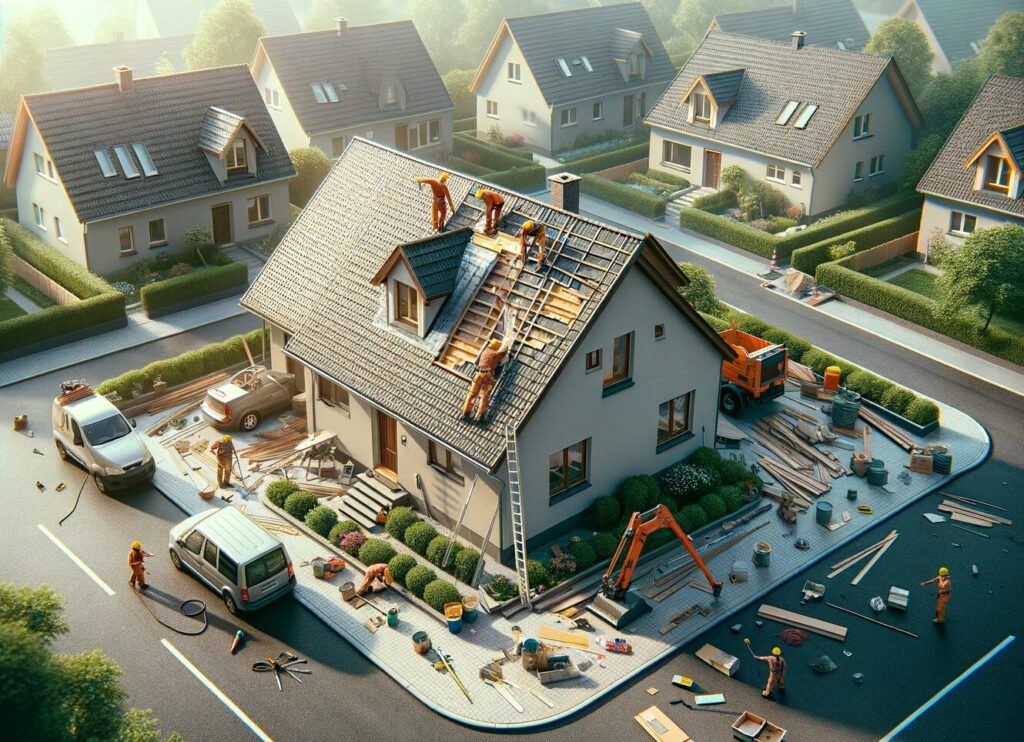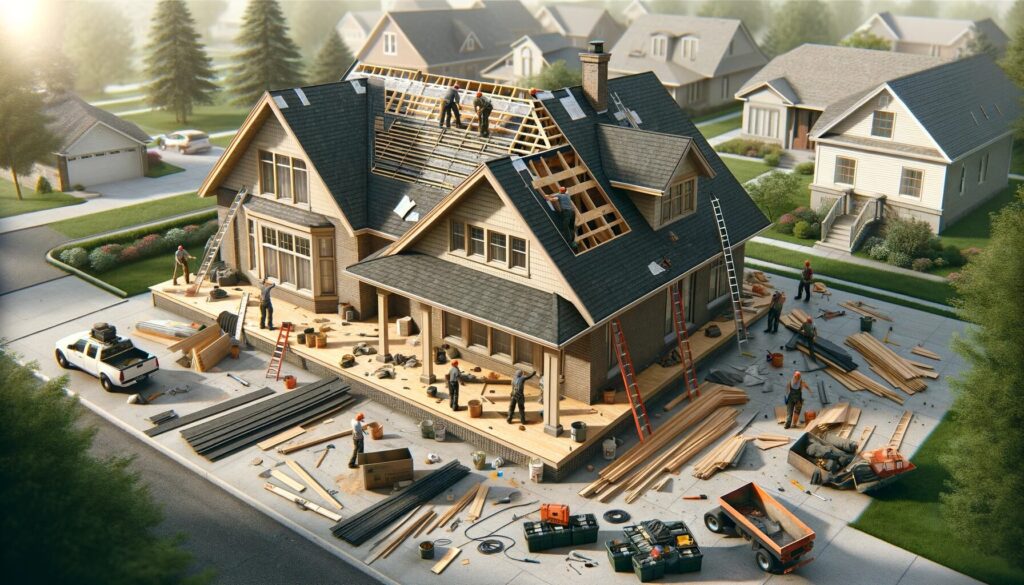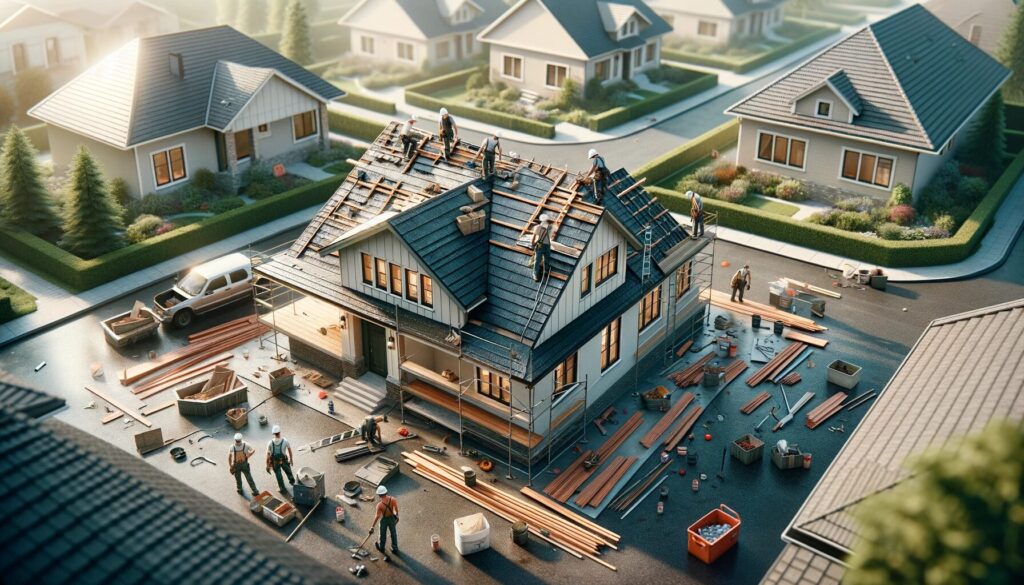When you’re dealing with roof replacement, it’s like opening a new chapter in your home’s life. This isn’t just about aesthetics, it’s about the integrity of your home’s shelter. Let’s delve into why this is such a crucial undertaking.
The Importance of Roof Replacement: A roof is more than just a cover, it’s the guardian of your home. Over time, this guardian bears the brunt of nature’s fury, leading to wear and tear that goes beyond surface deep. Signs like shingle deterioration or interior water damage are not just nuisances, they’re warnings that your home’s protective layer is failing. Replacing your roof is, therefore, not just a repair, but a renovation of your home’s first line of defense.
Roof Types and Lifespans: Roofs come in various types, each with its own lifespan and character. Asphalt shingles, common for their affordability, can last about 20-30 years. Metal roofs, on the higher end of durability, can serve you well for 40-70 years. And then there are the slate, tile, and wood shakes, each bringing a unique aesthetic and lifespan to the table. These lifespans are not set in stone, they fluctuate based on maintenance, climate, and the quality of installation.

Understanding Roof Replacement
Definition and Explanation: Roof replacement is a comprehensive process. It’s not just putting on a new layer, it involves stripping the old roof down to the deck, checking for structural integrity, and installing a new roofing system. It’s a total overhaul meant to ensure your home is protected for years to come.
When and Why It’s Necessary: There comes a time in every roof’s life when repairs just won’t cut it anymore. Signs to look out for include widespread cracking or curling shingles, frequent leaks, and a roof that’s past its expected lifespan. Roof replacement becomes necessary to avoid more severe damage like structural decay or mold growth, which can pose health risks and devalue your property.
Long-term Benefits: A new roof is more than just a quick fix, it’s a long-term investment in your home. It wards off future damage, enhances energy efficiency (which can save you money on utility bills), and increases your home’s market value. Moreover, it gives you peace of mind, knowing that your home is secure from the top down.
Preparing for Roof Replacement
Initial Steps: Inspection and Assessment: Your first move should be a thorough inspection by a seasoned professional. They can pinpoint underlying issues that need addressing before the new roof goes on. This step is crucial to avoid costly surprises during the replacement process.
Choosing the Right Materials: This is where you balance aesthetics, functionality, and budget. Each material, from the common asphalt shingle to high-end slate, has its pros and cons. Consider factors like local weather patterns, the architectural style of your home, and how long you plan to live there. It’s a decision that affects not just how your home looks but how well it stands up to the elements.
Budget Planning: Roof replacement is a significant financial undertaking. Costs vary widely depending on the materials you choose, the size of your roof, and labor charges. An asphalt roof might be more budget-friendly, while opting for materials like metal or slate will increase the project’s cost. Get detailed quotes, plan your budget carefully, and always allow a margin for unexpected expenses.

The Roof Replacement Process
In the world of roof replacement, it’s essential to approach the task with precision and understanding. Here’s a breakdown of the steps involved, learned from years on the job.
- Stripping the Old Roof: The first step involves removing the old shingles or tiles. This part requires a steady hand and a keen eye to ensure you don’t damage the roof deck beneath.
- Inspecting the Deck: Once the old roof is off, inspect the underlying deck. Look for signs of water damage or rot. It’s crucial to repair these issues before proceeding.
- Installing Underlayment and Flashing: Laying down the underlayment is like setting the foundation for your new roof. It’s a critical step for waterproofing. Proper flashing around chimneys, vents, and valleys is equally essential to prevent leaks.
- Laying New Shingles or Roofing Material: When installing new shingles, start from the bottom and overlap each row. Precision here ensures a watertight and visually pleasing finish.
Safety Precautions and Best Practices:
- Wear protective gear, including safety goggles, gloves, and non-slip boots.
- Ensure your ladder is stable and secure.
- Always be mindful of the weather, wet conditions can make roofing extremely hazardous.
DIY vs. Professional Help:
- For those with some experience and the right tools, DIY can be a viable option. However, consider the project’s scale and your comfort level with heights and construction tasks.
- Hiring professionals is advisable for complex roofs or when you’re not fully confident in your roofing abilities. Their expertise can be invaluable, and they come equipped to handle unexpected challenges.

Types of Roofing Materials
Choosing the right material is a critical decision in roof replacement. Here’s a rundown of the most common options:
- Asphalt Shingles:
- Pros: Affordable and easy to install. They come in various colors and styles.
- Cons: Shorter lifespan compared to other materials.
- Lifespan and Durability: Typically, they last 20-30 years.
- Metal Roofing:
- Pros: Durable, long-lasting, and energy-efficient.
- Cons: Higher initial cost and requires skilled installation.
- Lifespan and Durability: Can last 40-70 years.
- Tile Roofing:
- Pros: Excellent aesthetic appeal, fire-resistant, and very durable.
- Cons: Heavy and expensive, requiring a strong roof structure.
- Lifespan and Durability: Often lasts over 50 years.
Practical Tips for a Successful Roof Replacement
The final phase of roof replacement is preparation and cleanup, often overlooked but crucial for a smooth project.
- Preparing Your Home: Clear the area around your house. Move vehicles, outdoor furniture, and other belongings to protect them from falling debris. Inside, cover belongings in the attic to protect them from dust and debris.
- Maintaining a Safe Work Environment: Keep children and pets away from the work area. Clearly mark the work zone to prevent accidental intrusions.
- Waste Disposal and Cleanup: Renting a dumpster is a practical solution for handling debris. After the job, use a magnetic sweeper to collect any stray nails or metal pieces, ensuring the safety of your outdoor space.
Common Challenges in Roof Replacement
Roof replacement, like any significant home improvement project, comes with its own set of challenges. Drawing from decades of experience, here are some common scenarios you might encounter:
Weather-related Issues and How to Handle Them:
Unpredictable Weather: Always keep a close eye on the weather forecast. If rain is expected, be prepared to cover the roof with a tarp to prevent water damage. In extreme temperatures, either hot or cold, adapt your working hours. Start early in the day during heatwaves and handle materials carefully in the cold as they can become brittle.
Wind: High winds can be a hazard, especially when handling materials. Secure your materials and tools, and if the wind is too strong, it may be best to pause the work for safety.
Addressing Unexpected Damages or Issues:
- Hidden Damages: Often, it’s not until the old roof is removed that issues like water damage or rotten wood are discovered. Set aside a contingency budget for these unforeseen repairs. If structural issues are uncovered, it’s crucial to consult with a structural engineer to ensure the integrity of the roof.
- Asbestos: In older homes, be wary of asbestos. If there’s any suspicion, have the materials tested and, if present, professionally removed.
Dealing with Permits and Local Regulations:
- Building Permits: Most local authorities require a permit for significant roofing work. This is for your safety and ensures the work complies with local building codes.
- Zoning Laws and Neighborhood Restrictions: Be aware of any specific restrictions in your area, such as historic district regulations or homeowners association rules.
After the Replacement: Maintenance and Care
A new roof is a substantial investment, and like any investment, it requires care to maintain its value and functionality.
Post-replacement Inspection and Maintenance Tips:
- Initial Inspection: After the contractors have left, conduct a thorough inspection. Check the flashing, gutter work, and overall shingle alignment.
- Regular Maintenance: Biannual inspections are key. Look for signs of wear, such as loose or damaged shingles, and ensure gutters and downspouts are clear of debris.
Preventive Measures to Prolong the Life of Your New Roof:
- Tree Maintenance: Keep trees trimmed back from the roof. Overhanging limbs can scrape the roofing material and deposit debris.
- Ventilation and Insulation: Proper attic ventilation and insulation play a critical role in the lifespan of your roof by preventing heat buildup and condensation.
Recognizing Signs of Potential Problems:
- Interior Checks: Regularly check your attic for signs of leaks, especially after heavy rain.
- Visible Inspection: Look for signs of sagging or uneven roof lines, as these can indicate structural problems.
FAQ Section
Key indicators include age (20 years is a common benchmark), visible signs of wear like cracked or curling shingles, and frequent leaks. If your neighbors are getting new roofs, that could be a sign too, as homes built around the same time can experience similar wear.
The cost depends on various factors, including the roof size, the materials chosen, and labor costs in your area. For an asphalt shingle roof on a standard-sized home, costs can range from $5,000 to $10,000 or more for high-end materials.
While it’s possible for those with adequate experience and tools, roof replacement is a complex and potentially dangerous job. It involves not just installation skills but also knowledge of ventilation, insulation, and structural integrity. For most homeowners, hiring a professional is the safer and more efficient choice.
The timeframe can vary, but generally, a roof replacement on an average-sized home can take from a few days to a week. This is dependent on the weather, complexity of the roof, and the specific materials being used.
Climate plays a significant role in material selection. In areas with heavy snowfall, a sturdier material like metal roofing might be best. In hot, sunny climates, materials that reflect sunlight, like light-colored tiles, can help in keeping the house cooler.
